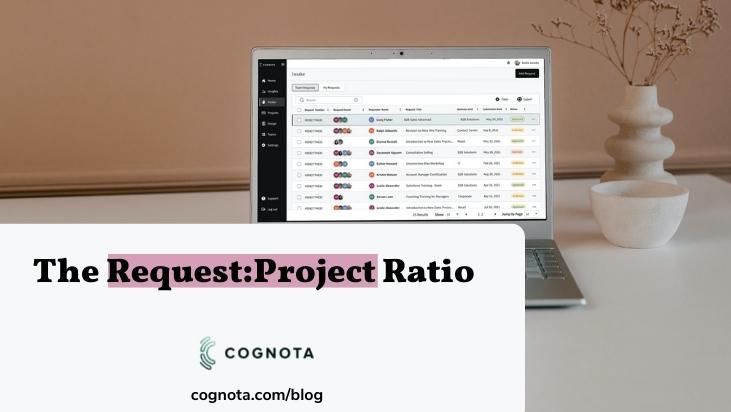Our Customer Success team explores the question “does every project start as a request?” and provides some practical frameworks you can use when exploring your approach to this.
One of the most common questions we get from customers is “does every project start as a request?” Answering this question depends on a number of factors such as where your requests come from, how strategic projects are defined, and the size and structure of your team.
We started to reflect on this Request:Project question and wanted to share some of the most common approaches we’ve seen, their benefits and things to be considerate of.

We’ll call this first framework the Request Funnel. With this approach, teams are receiving a high volume of requests. This often happens when the Cognota intake portal is distributed more broadly to all learners or employees in the organization so that they can submit their requests directly to the L&D team.
With this approach, it is likely that many of the requests will be waitlisted or declined due to reasons such as duplicate requests, lack of alignment with L&D strategies or resourcing. For your request:project ratio, you’ll see a higher volume of requests, and that will funnel down to the number of projects that your team is able to support.
Benefits
This framework is a great approach when you’re really looking to get a pulse on the training needs of the organization. You will get a lot of great insight into what’s required by various business units and be able to prioritize these requests based on learning impact, audience size and business urgency.
Things to Consider
One thing to consider with this approach is the bandwidth of your team to review all of the requests that are coming in as they are likely to be of a higher volume than what you’re able to support.
It’s also important to consider how you communicate back with requesters whose requests are being waitlisted or declined. Communicating the reason why you’re taking a specific action, is helpful to inform the requester but keep the door open for future requests.

With this model, you can visualize it as two stacked triangles. The top triangle is the Request Funnel and the bottom is your Strategic Project funnel. Here you’ll be receiving the projects that you’re working on from two main sources – your intake portal, as well as strategic projects that are being defined by annual planning or leadership.
For your Strategic Project funnel, you’ll likely see a similar flow where the number of initiatives presented to or raised by your team will likely exceed the bandwidth of your team, and these must be considered in relation to the other requests that are coming in from the broader organization.
Benefits
This framework is a great way to ensure that you’re keeping in mind both the requests of your employees and giving them a platform and voice to share their needs, while balancing the organization’s strategic needs and training requirements.
Things to Consider
With this approach, it’s very important to categorize where your projects are coming from. Were they raised through your intake portal, or were they surfaced via strategic planning or leadership. From an insights and analytics perspective, you might find that your Requests:Projects ratio is relatively balanced if you’re adding the strategic projects as Projects in Cognota versus requests.
Ensuring that your projects and requests are properly categorized can be a great way to report on how your team is supporting the business from both a request and strategic project perspective.

This framework represents an approach where you’re receiving multiple different types of requests through your Intake portal that are filtering to different individuals or teams. The Cognota intake process allows you to receive requests for various requirements such as New Content Development, Consulting and Mentoring, LMS Administration and Events.
With this approach, you’ll likely have multiple Request:Projects ratios for these different categories and we also see teams approving most requests that come through this model as they want to ensure that these types of requests are captured but they will usually all be actioned.
Benefits
Ensuring that all projects and tasks that your team is working on are captured as Requests is a great way to ensure that there is visibility into the time that’s being spent on all of these different types of work.
Often when organizations think of “intake” or “requests” they see it as net new initiatives, but there are so many other things that L&D teams are asked to support that this can be a great way to quantify this type of work.
Things to Consider
With this approach, you’ll want to ensure that your requests are being properly categorized. For example, a request for new content development will likely take a lot longer than a request for LMS enrolment. Ensuring this categorization is critical to keeping your analytics accurate.
You’ll also want to consider building out different project Processes in Cognota to support the work that’s happening downstream. For example, a request for Mentorship will be actioned in a different way than a request for Content Revision.

The last framework is one where we see a cyclical approach to Requests and Projects. A request might be raised, actioned and completed by the L&D team, but its lifecycle extends much longer. This would be the case for any content that was created or actioned, but needs to be reviewed or updated at a specific cadence.
In this case, your request funnel will need to consider these types of maintenance items that also require time and effort from your team.
Benefits
Thinking of your Request:Project ratio in this way can be really informative. Not all new content development is a one-time activity and building your content in a way that allows it to be easily maintained and defining regular review cycles can be a great way to keep on top of this.
Many teams we speak with have challenges with content lifecycle management and ensuring that there is alignment on when and how this content is updated and reviewed. Taking this approach where you’re always circling back to what’s been developed in the past can prove to be valuable.
Things to Consider
Setting up your processes in a way where you know which content needs to be reviewed, and defining that cadence is an important way to ensure that the right resources are being forecasted and scheduled to complete this work.
We’ve seen customers set up a process for content maintenance and set tasks and timelines for those review cycles.
What type of Request:Project ratio does your team see? The main takeaway is that you should be able to define what a Request is and what a Project is and be able to speak to the relationship between the two. This will help inform how you interpret your insights and analytics and ensure that there is alignment within your L&D team and between you and your stakeholders.




